NavSource Online: Aircraft Carrier Photo Archive
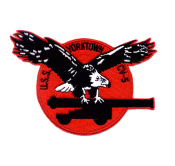
Courtesy of Don McGrogan, BMCS, USN Ret.

 |
||



|
| Yorktown Class Aircraft Carrier | |||||
| Ordered | Laid down | Launched | Commissioned | Decommissioned | Stricken |
|---|---|---|---|---|---|
| 3 Aug 1933 | 21 May 1934 | 4 Apr 1936 | 30 Sep 1937 | 2 Oct 1942 | |
| Builder: Newport News Shipbuilding & Drydock Co., Newport News, Va. | |||||
 |
Fate: Disabled by Japanese carrier aircraft bombs and torpedoes, 4 June 1942 (Battle of Midway) (read War Damage Report No. 25). Torpedoed by Japanese submarine I-168, 6 June. Sunk on 7 June 1942. A number of her crew were lost with the ship and remain on active duty. |
| Click on Thumbnail for Full Size Image |
Size | Image Description | Source |
|---|---|---|---|
| Name |
|||
 NS020538a |
101k | The Siege of Yorktown or Battle of Yorktown (28 September–19 October 1781) was a decisive victory by a combined assault of French forces led by General Comte de Rochambeau and American forces led by General George Washington, over a British Army commanded by General Lord Cornwallis. It proved to be the last major battle of the American Revolutionary War, as the surrender of Cornwallis's army (NS020538) prompted the British government to eventually negotiate an end to the conflict. Yorktown is a town in Virginia (NS020538a). Two previous US warships had borne the name: Map NS020538a courtesy of Google Maps. NS020538: Surrender of Cornwallis at Yorktown, by John Trumbull (oil on canvas, 1820). |
NavSource Partial text and painting courtesy of Wikipedia |
 NS020538 |
162k | ||
| Construction, 1934–1937 |
|||
 NS020586 |
653k | The future USS Yorktown (CV-5), looking forward at Newport News Shipbuilding and Dry Dock Company, Newport News, Virginia, 3 July 1934. National Archives and Records Administration (NARA) photo, # 19-LC-17257. |
NARA |
 NS020586a |
591k | The future USS Yorktown (CV-5), looking aft at Newport News Shipbuilding and Dry Dock Company, Newport News, Virginia, 3 July 1934. National Archives and Records Administration (NARA) photo, # 19-LC-17259. |
|
 NS020589 |
635k | The future USS Yorktown (CV-5), looking aft. Newport News Shipbuilding and Dry Dock Company, Newport News, Virginia, 1 October 1934. National Archives and Records Administration (NARA) photo, # 19-LC-17260. |
NARA |
 NS020589a |
391k | The future USS Yorktown (CV-5), looking forward. Newport News Shipbuilding and Dry Dock Company, Newport News, Virginia, 1 October 1934. National Archives and Records Administration (NARA) photo, # 19-LC-17261. |
|
 NS020527b |
560k | Future USS Yorktown (CV-5), bow view before launching, Newport News Shipbuilding and Dry Dock Company, Newport News, Virginia, 4 April 1936. National Archives and Records Administration (NARA) photo, # 19-LC-41209a. |
NARA |
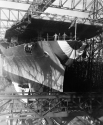 NS020527c |
698k | Future USS Yorktown (CV-5), bow view before launching, Newport News Shipbuilding and Dry Dock Company, Newport News, Virginia, 4 April 1936. National Archives and Records Administration (NARA) photo, # 19-LC-41209b. |
NARA |
 NS020527d |
393k | The future USS Yorktown (CV-5) being launched by sponsor, Ms. Eleanor Roosevelt, wife of President Franklin D. Roosevelt, at Newport News Shipbuilding and Dry Dock Company, Newport News, Virginia, 4 April 1936. National Archives and Records Administration (NARA) photo, # 19-LC-41209. |
NARA |
 NS020527e |
474k | First Lady Eleanor Roosevelt christens Yorktown (CV-5), 4 April 1936. National Archives and Records Administration (NARA) photo, Series: Franklin D. Roosevelt Library Public Domain Photographs, 1882–1962; Collection: Franklin D. Roosevelt Library Public Domain Photographs, 1882–1962. NARA identifier: 195630. |
NARA, via Michael Mohl |
 NS020527a |
209k | Yorktown (CV-5) is christened by Mrs. Franklin D. Roosevelt, during launching ceremonies at the Newport News Shipbuilding and Dry Dock Company, Newport News, Virginia, 4 April 1936. Photograph from Department of the Navy collections in the U.S. National Archives (photo #80-CF-80301-1). |
Gerd Matthes, Germany |
 NS020527f |
1.39M | Newport News, Va. (4 April 1936)—The future USS Yorktown (CV-5) starts to slide down the ways, as she is launched at Newport News Shipbuilding and Dry Dock Company. She was just christened by her sponsor Mrs. Franklin D. Roosevelt (Anna Eleanor Roosevelt). Wide World Photos #846395. |
Robert M. Cieri |
 NS020527 |
131k | USS Yorktown (CV-5) afloat immediately after launching, at the Newport News Shipbuilding and Dry Dock Company, Newport News, Virginia, 4 April 1936. Official U.S. Navy Photograph, now in the collections of the National Archives (photo # 80-G-462850). |
Scott Dyben |
 NS020581 |
1.38M | "Floating Flying Field Launched—Air view of the new aircraft carrier Yorktown as the ship glided down the ways at Newport News yesterday after being christened by Mrs. Franklin D. Roosevelt." The Sunday Star, Washington, D.C., 5 April 1936. |
Library of Congress, Chronicling America, via Michael Mohl |
 NS020582 |
377k | "Newport News, Va., Ship yard, Rec'd from Langley Field, Va., 4/28/36" Monday, 20 April 1936. Yorktown (CV-5), fitting out, can be seen on the right side of the photo. National Archives and Records Administration (NARA), Record Group 18, National Archives Identifier 68150851, Local Identifier 18-AA-129-24. |
NARA, via Michael Mohl |
 NS020583 |
650k | Yorktown (CV-5) under construction at Newport News Shipbuilding Company, Virginia. Photographed on Friday, 10 July 1936. U.S. Navy Photograph, now in the collections of the National Archives and Records Administration (NARA), # 80-G-462079. |
NARA, via Michael Mohl |
 NS020577 |
961k | The future USS Yorktown (CV-5), left, and USS Enterprise (CV-6) at a Yard pier in Norfolk, during outfitting in 1937. Newport News Shipbuilding photo, # DCS19-23-8. |
Bob Haner, YN1, USN (Ret.) |
 NS020533 |
94k | USS Enterprise (CV-6), left, and USS Yorktown (CV-5) under construction at Newport News, Virginia, 8 February 1937. National Archives photo. |
Steve Whitby |
 NS020534 |
185k | USS Yorktown (CV-5) foreground, and USS Enterprise (CV-6) under construction at Newport News, Virginia, 8 February 1937. National Archives photo. In the background is Boise (CL-47), being completed. (Thanks to Jonathan Eno for the information.) |
Steve Whitby |
 NS020572 |
91k | USS Yorktown (CV-5) photographed during builder's trials, May 1937. Naval History & Heritage Command photo (# NH 42341). |
Mike Green |
 NS020528 |
139k | USS Yorktown (CV-5) at the Newport News Shipbuilding and Dry Dock Company, Newport News, Virginia, in June 1937, while preparing for sea trials. Note her chrome yellow flight deck markings, applied over maroon-stained douglas fir deck planking. USS Enterprise (CV-6) is fitting out in the drydock in upper center. USS Boise (CL-47) is two piers over from Yorktown, also fitting out. Several merchant ships are also present. Official U.S. Navy Photograph, now in the collections of the National Archives (photo # 80-G-462977). |
Scott Dyben |
 NS020537 |
63k | At anchor in the Rockland, Maine area. Possibly taken in July 1937, during preliminary standardization trials. |
Photo by Sanford F. Delano, of Rockland, Maine. Submitted by his son, Sanford R. Delano |
 NS020539 |
82k | Yorktown making 17.5 knots, astern, during preliminary standardization trials, run # 41, off Rockland, Maine, 12–21 July 1937. She is pushing up a handsome "moustache" stern wave. Carriers of this class were required to make good speed astern, to allow landing planes over the bow and launching over the stern if necessary. National Archives photo # 19-N-17422. |
Paul Rebold |
NS020540 |
53k | Another view of Yorktown, possibly taken during preliminary standardization trials, July 1937. |
Robert Hurst |
 NS020502 |
499k | Starboard bow, underway, 21 July 1937. National Archives and Records Administration (NARA) photo, # 19-N-17424. |
NARA |
 NS020578 |
356k | Yorktown (CV-5), possibly during her trials, July 1937. |
Courtesy of Jim Kurrasch, Battleship Iowa, Pacific Battleship Center |
 NS020541 |
100k | View looking aft along the starboard side, at hangar deck level, from below the forward end of the island, August 1937. Note hose connection in the foreground, motor whaleboat (with "Yor" bow letters), life lines and other details. U.S. Naval Historical Center Photograph (# NH 50338). |
Paul Rebold |
 NS020542 |
252k | 5-inch/38 caliber dual-purpose gun mounted on the ship's after starboard gun platform, looking aft and to starboard. Photographed at the Newport News Shipbuilding & Dry Dock Company on 27 September 1937. Note fuze-setting mechanism on the gun mount's left side and non-skid rubber matting on the deck. National Archives photo # 19-N-17439. |
Paul Rebold Larger copy submitted by Mike Green |
 NS020556 |
112k | Bow area, forecastle, forward end of flight deck; 27 September 1937. |
Pieter Bakels |
| Pre-War, 1937–1941 |
|||
 NS020504 |
94k | USS Yorktown (CV-5) tied up at Pier 7, Naval Operating Base Norfolk, Virginia, on 30 September 1937, with commissioning ceremonies underway on her flight deck. USS Jacob Jones (DD-130) is on the opposite side of the pier. |
USN |
 NS020543 |
161k | Crew paraded on the flight deck during the ship's commissioning ceremonies, 30 September 1937. She was then tied up at the Naval Operating Base, Norfolk, Virginia. The Marine detachment is in the lower left center. Note aircraft tie-down strips laid at regular intervals among the flight deck planks. U.S. Naval Historical Center Photograph (# NH 50335). |
Paul Rebold |
 NS020543a |
87k | Rear Admiral Charles A. Blakely, USN, Commander, Carrier Division Two (COMCARDIVTWO, on board USS Yorktown (CV-5), during the ship's commissioning ceremonies, at Naval Operating Base, Norfolk, Virginia, 30 September 1937. Standing with him is the ship's Commanding Officer, Captain Ernest D. McWhorter, USN. Behind them are (from left to right): Captain Newton H. White, USN, ComCarDivTwo Chief of Staff; unidentified Commander; Lieutenant Commander Leslie E. Gehres, USN; Lieutenant Commander Harold F. Fick, USN; two unidentified officers and Lieutenant Bennett W. Wright. Photograph from Department of the Navy collections in the U.S. National Archives (#80-CF-8008-3). |
Naval History & Heritage Command |
 NS020544 |
100k | Forward part of the ship's port side, while she was tied up at the Naval Operating Base, Norfolk, Virginia. Men in ranks on the flight deck indicate that this view was probably taken during her commissioning ceremonies, 30 September 1937. U.S. Naval Historical Center Photograph (# NH 50336). |
Paul Rebold |
 NS020573 |
113k | USS Yorktown (CV-5) alongside a pier at Naval Operating Base, Norfolk, Virginia, 2 October 1937. U.S. Naval History and Heritage Command photograph, # NH 42342. |
Mike Green |
 NS020545 |
105k | USS Yorktown (CV-5) tied up at Naval Operating Base, Norfolk, Virginia, in October 1937. Note details of the ship's bow area, including the retractable navigation light mast on the flight deck. U.S. Naval Historical Center Photograph (# NH 50332). |
Paul Rebold |
 NS020546 |
124k | Starboard side of the ship's smokestack, taken at Naval Operating Base, Norfolk, Virginia, in October 1937. The ship is flying the two-star flag of Rear Admiral Charles A. Blakely, Commander, Carrier Division Two. Note details of searchlight and signal lamp platforms, working catwalks around the stack top and mainmast with 48-star national ensign. Barrels of a pair of saluting guns are visible at the extreme right, above the boat crane boom. U.S. Naval Historical Center Photograph (# NH 50334). |
Paul Rebold |
 NS020547 |
108k | USS Yorktown (CV-5) tied up at Naval Operating Base, Norfolk, Virginia, in October 1937. The ship is flying the two-star flag of Rear Admiral Charles A. Blakely, Commander, Carrier Division Two. Note anchors, jack flying forward, and retractable navigation light mast on the flight deck. U.S. Naval Historical Center Photograph (# NH 50337). |
Paul Rebold |
 NS0513003 |
109k | USS Yorktown (CV-5), USS Texas (BB-35), USS Decatur (DD-341), USS Jacob Jones (DD-130), and unidentified tug at Pier 7, Naval Operating Base, Norfolk, Virginia, on 19 October 1937. Photograph from Department of the Navy collections in the U.S. National Archives (# 80-CF-2115-11). |
Joe Radigan |
 NS020579 |
588k | Starboard bow view of USS Yorktown (CV-5) during Navy Day Celebrations (1937?), while moored at Norfolk Operating Base in Norfolk, Virginia. Norfolk Public Library, Sargeant Memorial Collection. |
Mike Green |
 NS020548 |
105k | USS Yorktown (CV-5) anchored in Hampton Roads, Virginia, 30 October 1937. U.S. Naval Historical Center Photograph (# NH 50304). |
Paul Rebold |
 NS020549 |
100k | USS Yorktown (CV-5) anchored in Hampton Roads, Virginia, 30 October 1937. U.S. Naval Historical Center Photograph (# NH 50330). |
Paul Rebold |
 NS020550 |
111k | USS Yorktown (CV-5) in Hampton Roads, Virginia, 30 October 1937. U.S. Naval Historical Center Photograph (# NH 50333). |
Paul Rebold |
 NS020550a |
112k | USS Yorktown (CV-5) anchored in Hampton Roads, Virginia, 30 October 1937. Boat booms are rigged out, with boats tied up to them. Note details of the ship's stern, including her name, structure supporting the after flight deck, and motor launch stowed athwartship on platform between the main and flight decks. Naval History & Heritage Command photograph (#NH 51821). |
Gerd Matthes, Germany |
 NS020550b |
70k | USS Yorktown (CV-5) anchored in Hampton Roads, Virginia, 30 October 1937. Boat booms are rigged out. Naval History & Heritage Command photograph (#NH 51822). |
Gerd Matthes, Germany |
 NS020550c |
135k | USS Yorktown (CV-5). View of the starboard side, amidships, taken while the ship was anchored in Hampton Roads, Virginia, 30 October 1937. Note details of the island, with pilothouse and battle lookout at its top front, accomodation ladders, boat booms and boats. Naval History & Heritage Command photograph (#NH 51823). |
Gerd Matthes, Germany |
 NS020550d |
117k | USS Yorktown (CV-5). View looking forward on the starboard side, from amidships, in Hampton Roads, Virginia, 30 October 1937. Note details of the island, with small boat crane located alongside it. The anti-aircraft battery of 1.1" quadruple machinegun mounts has not yet been installed. Naval History & Heritage Command photograph (#NH 51824). |
Gerd Matthes, Germany |
 NS020550e |
92k | USS Yorktown (CV-5) in Hampton Roads, Virginia, with her port anchor out, 30 October 1937. Note Landing Signal Officer platform near the front of her flight deck, for use in landing planes over the bow. Naval History & Heritage Command photograph (#NH 51825). |
Gerd Matthes, Germany |
 NS020536 |
132k | Port bow view of USS Yorktown (CV-5) circa 1937, place unknown. Navy photo; # 4396-43. |
Darryl Baker |
 NS020560 |
67k | Undated pre-war pic of USS Yorktown (CV-5). Note the open hangar deck; sliding bulkheads closed off the hangars at night and in rough weather (USN photo). From "Aircraft Carriers," by Norman Polmar. |
Robert Hurst |
 NS020562 |
121k | Another pre-war view of USS Yorktown (CV-5). Date and location unknown. |
Tommy Trampp |
 NS020529 |
131k | USS Yorktown (CV-5) anchored in the Caribbean Sea area, 17 January 1938, during her shakedown cruise. Official U.S. Navy Photograph, now in the collections of the National Archives (photo # 80-G-466153). |
Scott Dyben |
 NS020587 |
251k | "USS Yorktown's hangar bay on 1 February 1938, showcasing a portable elevator used to change light fixtures in her hangar bay. One detail this shows is the probability that the interior hangar surfaces were painted in some sort of silver or aluminum paint, probably for reflective reasons to decrease shadows when working on aircraft. Note that some of the white signs in the background are significantly brighter than the bulkheads they are mounted on. Likewise, the portholes that are flipped up in 80-CF-21156-2 are the same tone as the bulkhead walls or lighter, despite being painted a light gray (#5 Standard Navy Gray). Conventional wisdom has been that hangar spaces were painted the same white on the bulkheads and overheads as other spaces, but as cruiser hangars were known to have been painted in a metallic silver or aluminum paint, it is likely that Yorktown's hangar space was painted this way through her war time experience." NS020587: US Navy photo now in the custody of the US National Archives and Records Administration, College Park, Maryland, # 80-CF-21156-2. NS020587a: US Navy photo now in the custody of the US National Archives and Records Administration, College Park, Maryland, # 80-CF-21156-3. |
Tracy White, Researcher @ Large |
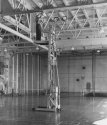 NS020587a |
300k | ||
 NS020563 |
105k | USS Yorktown (CV-5) at anchor. This photo was featured in the 1939 edition of Jane's Fighting Ships and was most likely taken early that year, in the Caribbean, just prior or just after Fleet Problem XX. |
Charles Landrum, LCDR, USN, Ret. |
 NS020552 |
541k | Flight deck scene, during a lull in air operations while participating in Fleet Problem XX, February 1939. Planes are Grumman F2F-1 fighters, of Fighting Squadron Five (VF-5). That in the center, coded "5-F-2", is Bureau # 9664. Note gun cameras mounted atop the planes' upper wings; signal flags flying; details of the ship's island; and large "Y" painted on her stack for identification purposes. Photograph from Department of the Navy collections in the U.S. National Archives and Records Administration (NARA) photo, # 80-CF-5485-2. |
NARA, via Gerd Matthes, Germany |
 NS020530 |
98k | USS Yorktown (CV-5) anchored off Gonaives, Haiti, 23 (28?) February 1939, following Fleet Problem XX. Photographed by Chief Photographer Mihalovic, from USS Enterprise (CV-6). Official U.S. Navy Photograph, now in the collections of the National Archives (photo # 80-G-64784). |
Scott Dyben |
 NS0818605a |
95k | On 20 April 1939 the Stingray (SS-186) transited the Panama Canal and arrived at San Diego, Calif., on 11 May for a rigorous schedule of training and maneuvers as a unit of Submarine Squadron 6. Following Fleet Problem XX, Yorktown (CV-5) returned briefly to Hampton Roads before sailing for the Pacific on 20 April. Transiting the Panama Canal a week later, Yorktown soon commenced a regular routine of operations with the Pacific Fleet. (Quoted from DANFS, Dictionary of American Naval Fighting Ships.) Both ships are seen here around that time. |
USN photo courtesy of Scott Koen & ussnewyork.com |
 NS020554 |
513k | Aerial photograph of Naval Air Station, North Island, San Diego, California, taken 28 June 1939, from a USS Enterprise (CV-6) airplane. USS Yorktown (CV-5) and USS Wright (AV-1) are tied up at the Air Station pier. Enterprise is in mid-stream, beyond them. Photograph from Department of the Navy collections in the U.S. National Archives and Records Administration (NARA), #80-CF-37125-1. |
Gerd Matthes, Germany Larger copy submitted by Gordon Buttars Bob Canchola, BT, USN (Ret.) |
 NS020585 |
362k | USS Yorktown (CV-5), possibly in the summer of 1939 and flying the flag of VADM Charles A. Blakely, Commander, Aircraft, Battle Force (COMAIRBATFOR) and Commander, Carrier Division 2 (COMCARDIV 2). Official US Navy photo. |
Robert M. Cieri |
 NS020565 |
103k | "The Yorktown (CV-5), in 1940, only slightly modified since her completion. She was armed with eight 5-in/38, four quadruple 1.1-in, and twenty-four single 0.50-cal machine guns. The plan view shows aircraft outriggers extended; they are stowed in the elevation. Note the forward arresting wires and the platform for an LSO to control over-the-bow landings, as well as the two windbreaks." Drawing and text from U.S. Aircraft Carriers: An Illustrated Design History, by Norman Friedman. |
Robert Hurst |
NS020574 |
16.8M | USS Yorktown (CV-5), Booklet of General Plans, corrected to suit ship, February 1940. |
Courtesy of the Historic Naval Ships Association |
 NS020553 |
935k | Aerial photograph of Naval Air Station, North Island, San Diego, California, taken from a Marine Aircraft Group Two (MAG-2) plane, 29 March 1940. USS Yorktown (CV-5) is docked at the top, embarking her air group, prior to departure for Hawaii to take part in Fleet Problem XXI. Airplanes are taxiing from the airfield (lower right) through the air station's streets to the carrier pier to be loaded on board the ship. Note airship hangar in lower center. Photograph from Department of the Navy collections in the U.S. National Archives and Records Administration (NARA), #80-CF-2115-10. |
Gerd Matthes, Germany Bob Canchola, BT, USN (Ret.) |
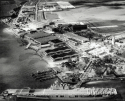 NS020553a |
920k | Possibly as above. |
Bob Canchola, BT, USN (Ret.) |
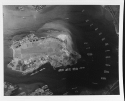 NS020584 |
406k | Pearl Harbor, vertical aerial photograph from 17,200 feet altitude, looking directly down on East Loch and on the Fleet Air Base on Ford Island. Taken on 3 May 1940, after the conclusion of Fleet Problem XXI, and just prior to the 7 May receipt of word that the Fleet was to be retained in Hawaiian waters. There are eight battleships and the carrier Yorktown (CV-5) tied up along the island's southeastern side (toward the top), with two more battleships alongside 1010 dock at top right center. Two light cruisers and two destroyers are among the ships moored along Ford Island's northwestern side. Seventeen other cruisers and over thirty destroyers are also visible, mainly in East Loch. At the seaplane base, at the southern (top right) tip of Ford Island, are at least 38 PBY patrol planes. Official U.S. Navy Photograph, now in the collections of the National Archives and Records Administration (NARA), # 80-G-411117. |
Naval History & Heritage Command |
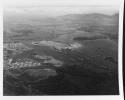 NS020584a |
216k | Pearl Harbor, vertical aerial photograph from 4000 feet altitude, looking southwestward, with the U.S. Fleet at moorings. Taken on 3 May 1940, after the conclusion of Fleet Problem XXI. This was four days before word was received that the Fleet was to be retained in Hawaiian waters. There are eight battleships and the carrier Yorktown (CV-5) tied up along the near side of Ford Island, in the center of the harbor. Two more battleships and many cruisers, destroyers and other Navy ships also present. Official U.S. Navy Photograph, now in the collections of the National Archives and Records Administration (NARA), # 80-G-411119. |
|
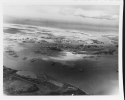 NS020584b |
209k | Pearl Harbor, vertical aerial photograph from 2500 feet altitude, looking southward, showing the U.S. Fleet moored in the harbor on 3 May 1940. This was soon after the conclusion of Fleet Problem XXI and four days before word was received that the Fleet was to be retained in Hawaiian waters. There are eight battleships and the carrier Yorktown (CV-5) tied up by Ford Island, in the center of the harbor. Two more battleships and many cruisers, destroyers and other Navy ships also present, most of them moored in groups in East Loch, in the foreground. A few of the destroyers are wearing experimental dark camouflage paint. In the distance, center, is Hickam Army Air Field. The Pearl Harbor entrance channel is in the right distance. Official U.S. Navy Photograph, now in the collections of the National Archives and Records Administration (NARA), # 80-G-411120. |
|
 NS020501 |
459k | USS Yorktown (CV-5) at Naval Air Station, North Island, San Diego, California, in June 1940, embarking aircraft and vehicles prior to sailing for Hawaii. Aircraft types on her flight deck include TBD-1, BT-1, SBC-3, F3F-2, F3F-3, SB2U, JRF, J2F and JRS-1. Some of these planes were on board for transportation, while others were members of the ship's air group. Three Torpedo Squadron Five (VT-5) TBDs at the after end of the flight deck are painted in experimental camouflage schemes tested during Fleet Problem XXI. Official U.S. Navy photograph, now in the collections of the U.S. National Archives and Records Administration (NARA), #80-G-651042. |
Wolfgang Hechler |
 NS020501a |
783k | As above?. |
Bob Canchola, BT, USN (Ret.) |
 NS020508 |
130k | Douglas TBD-1 Torpedo Planes, of Torpedo Squadron Five (VT-5), parked on the
after flight deck of USS Yorktown (CV-5) at Naval Air Station, North Island, San Diego,
California, in June 1940. Three of these aircraft are painted in an experimental color scheme
used during Fleet Problem XXI. This section of the ship was examined when Yorktown's
wreck was located in May 1998. The after thirty feet (approximately) of the flight deck was
missing, but most other features seen were present, including the ship's name on her stern. This view (Naval History & Heritage Command photo (# NH 95314) is cropped from Photo 80-G-651042, above. |
Michael Mohl |
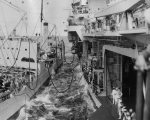 NS091900403 |
74k | Brazos (AO-4) refueling Yorktown (CV-5) mid-Pacific, July 1940. US National Archives, (Seattle Branch) RG-181. |
Tracy White |
 NS020568 |
119k | [This] Douglas TBD-1 Devastator ended up in the catwalk abaft the bridge of USS Yorktown (CV-5), on 3 September 1940 following a landing accident. This particular aircraft was subsequently repaired and assigned to Torpedo Eight, and was one of the many such aircraft lost during the Battle of Midway on 4 June 1942. Naval History & Heritage Command photo. Photo and text from Midway: Dauntless Victory, by Peter C. Smith. |
Robert Hurst |
 NS020559 |
248k | Ensign Arthur J. Brassfield, USN, of Fighting Squadron 42 (VF-42) oversees engine maintenance on one of VF-42's F4F-3A fighters, on the flight deck of USS Yorktown (CV-5) at Casco Bay, Maine, 13 November 1941. Note SBD-3 in background, carrying an anti-submarine depth bomb; light gray color scheme on both planes; .50 caliber machine gun, telescopic gunsight and variable-pitch propeller on the F4F; and Ensign Brassfield's aviation winter green uniform and leather jacket. Also note what appears to be a file in the mechanic's back pocket, providing an opportunity for later medical treatment. Official U.S. Navy Photograph, now in the collections of the U.S. National Archives (#80-G-64709). |
Gerd Matthes, Germany |
| World War II |
|||
 NS020575 |
376k | An unidentified US destroyer approaches a downed Douglas SBD Dauntless to take aboard its pilot and gunner. The aircraft was one of nine SBDs launched from the aircraft carrier USS Yorktown (CV-5) that had attacked Makin Island, on 1 February 1942. U.S. Navy photo. |
Robert Hurst |
 NS020505 |
454k | U.S. Navy SBD Dauntless dive bombers from USS Yorktown (CV-5) over Makin Atoll during the February 1942 Marshalls-Gilberts raids. Aircraft in background is flown by flight leader LCDR Bill Burch. Aircraft in foreground is piloted by Ensign Thomas A. Reeves. Photo taken by Photographer's Mate 2nd Class J. V. Pflaum. From That Gallant Ship USS Yorktown (CV-5), by Robert J. Cressman. |
Robert Hurst |
 NS020576 |
203k | USS Yorktown (CV-5) returns to Pearl Harbor, 6 February 1942, after the Marshalls-Gilberts raids. Photographed from USS Enterprise (CV-6), this view shows the Measure 12, Graded System, camouflage that Yorktown received in late 1941. Also seen is the external degaussing cable that was installed on her hull just below the deck edge. The hull number (5) has not yet been painted on her side, just aft of the anchor. All those features were observed when the ship was examined, at a depth of some three miles, on 20 May 1998, though her bow hull structure was heavily distorted. The superstructure of USS Saratoga (CV-3), then undergoing repairs for torpedo damage, is visible in the right center background. Naval History and Heritage Command (NH&HC), Photo No. NH 95551. |
NH&HC, via Mike Green |
 NS020566 |
127k | Armed with bombs, Douglas TBD-1 Devastator aircraft from Torpedo Squadron (VT) 5, assigned to the aircraft carrier USS Yorktown (CV-5), prepare to attack Japanese shipping supporting the invasion of Lae-Salamaua, New Guinea, 10 March 1942, in the Huon Gulf. Two Japanese ships, possibly the auxiliary vessel Noshiro Maru and auxiliary minesweeper Hagoromo Maru, can be seen making a smoke screen below in anticipation of the air attack. The first plane on the left was piloted by Joe Taylor, the second by Leonard E. Ewoldt, and the third by Francis R. Sanborn. Photo by Photographer's Mate 2nd Class F.J. Meers, USN. From That Gallant Ship USS Yorktown (CV-5), by Robert J. Cressman. |
Robert Hurst |
 NS020566a |
429k | SBD Dauntless aircraft of Scouting Squadron (VS) 5 from USS Yorktown (CV-5) during the attack on Japanese shipping off Lae and Salamaua, New Guinea, 10 March 1942. Below the two aircraft are the Japanese minelayer Tenyo Maru, auxiliary transport Kokai Maru, and auxiliary cruiser Kongo Maru. Tenyo Maru and Kongo Maru were sunk in the subsequent air attack. Photo taken by PhoM2c Walter C. Goldie. From That Gallant Ship USS Yorktown (CV-5), by Robert J. Cressman. |
|
 NS020557 |
304k | Marines man the ship's forward port side 20mm gun battery, circa Spring 1942. Camera is looking aft. Note details of gun mountings and shields, rubber non-skid mats on deck and splinter protection on the outboard side of the gun gallery. Aircraft arresting gear is visible on the flight deck, at left. As a result of combat experience, 20mm gun shields were later modified with angled cut-outs on the inside top of each plate, providing the gunner with better vision to each side of the aiming point. 20mm guns were fitted when the ship was at Norfolk Navy Yard in December 1941. Those in this gun gallery were jettisoned during salvage efforts on 6 June 1942. When Yorktown's wreck was examined in May 1998, this area was observed in detail, and all the guns and mountings seen here were missing, as were the middle segments of each gun position's splinter protection plating. Official U.S. Navy Photograph, now in the collections of the U.S. National Archives (photo # 80-G-21929). |
Gerd Matthes, Germany |
| Battle of the Coral Sea, May 1942 |
|||
 NS020531 |
62k | Sunrise/sunset view looking aft from the forward part of the flight deck, during operations in the Coral Sea area, April 1942. Official U.S. Navy Photograph, now in the collections of the National Archives (photo # 80-G-464630). |
Scott Dyben |
 NS020532 |
122k | USS Yorktown (CV-5), operating in the vicinity of the Coral Sea, April 1942. Photographed from a TBD-1 torpedo plane that has just taken off from her deck. Other TBD and SBD aircraft are also ready to be launched. A F4F-3 Wildcat fighter is parked on the outrigger just forward of the island. Other ships in company include a fleet oiler, a destroyer and a heavy cruiser. This view has been retouched to censor the radar antenna mounted atop Yorktown's foremast. Official U.S. Navy Photograph, now in the collections of the National Archives (photo # 80-G-640553). |
Scott Dyben |
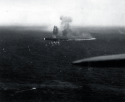 NS020580 |
761k | Japanese aircraft carrier Shokaku attacked by USS Yorktown (CV-5) planes, during the morning of 8 May 1942. Flames from a bomb hit on her forecastle are visible, as are smoke and splashes from dive bombers' near misses off her starboard side. Photographed from a Torpedo Squadron Five TBD-1 Devastator. What appear to be erratic torpedo tracks are visible in the lower left. Official U.S. Navy Photograph, now in the collections of the National Archives and Records Administration (NARA), # 80-G-17030. |
NARA |
 NS020580a |
428k | Close up of the photo above. Official U.S. Navy Photograph, now in the collections of the National Archives and Records Administration (NARA), # 80-G-17030A. |
|
 NS020580b |
503k | Japanese aircraft carrier Shokaku under attack by USS Yorktown (CV-5) planes, during the morning of 8 May 1942. Flames are visible from a bomb hit on her forecastle. Official U.S. Navy Photograph, now in the collections of the National Archives and Records Administration (NARA), # 80-G-17031. |
|
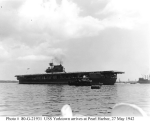 NS140814601 |
55k | USS Yorktown (CV-5) arrives at Pearl Harbor after the Battle of Coral Sea, 27 May 1942, with her crew paraded in whites on the flight deck. After repairs, she departed on 30 May to take part in the Battle of Midway. The tug Hoga (YT-146) is in the center foreground. The mainmast of the sunken USS Arizona (BB-39) is visible in the distance, just right of Yorktown's stern. Official U.S. Navy Photograph, now in the collections of the U.S. National Archives (#80-G-21931). |
NH&HC |
 NS020503 |
749k | In Dry Dock # 1 at the Pearl Harbor Navy Yard, 29 May 1942, receiving urgent repairs for damage received in the Battle of Coral Sea. She left Pearl Harbor the next day to participate in the Battle of Midway. Note the raised 20-mm/70-cal Oerlikon AA mounts beneath the forward edge of the flight deck. The CXAM radar antenna is in the "down" position, and is therefore out of sight. (Thanks to Robert Hurst, who provided additional info). USS West Virginia (BB-48), sunk in the 7 December 1941 Japanese air attack, is being salvaged in the left distance. Official U.S. Navy Photograph, now in the collections of the U.S. National Archives and Records Administration (NARA), # 80-G-13065. |
NARA |
| Battle of Midway, June 1942 |
|||
 NS020506a |
319k | USS Yorktown (CV-5) underway with her air group on the flight deck, 4 June 1942, probably about 0630–0730 hrs, following recovery of her morning search and respotting the flight deck with her strike group. Several SBD scout bombers are on deck alongside and forward of the island, with many other planes densely parked aft. TBD torpedo bombers are at the flight deck's rear. Official U.S. Navy Photograph, now in the collections of the U.S. National Archives (photo # 80-G-21627). |
Gerd Matthes, Germany |
 NS020506c |
191k | An SBD Dauntless scout bomber passes low over USS Yorktown (CV-5), possibly to drop a message, 4 June 1942. Planes parked aft appear to be TBD Devastator torpedo planes, indicating that the photo was taken sometime before 0840 hrs, when Yorktown launched her aircraft to attack the Japanese aircraft carrier force. Official U.S. Navy Photograph, now in the collections of the U.S. National Archives (photo # 80-G-23842). |
Gerd Matthes, Germany |
 NS020506e |
67k | A Douglas SBD-3 Dauntless dive-bomber "warming up" aboard the aircraft carrier USS Yorktown (CV-5) prior to take-off for a strike on the morning of 4 June 1942. Naval Institute Photo Collection via Naval Historical Foundation, Washington, D.C. |
Robert Hurst |
 NS020506d |
70k | A Douglas SBD-3 Dauntless scout bomber (Bureau # 4542), of USS Enterprise's Bombing Squadron Six (VB-6), on USS Yorktown (CV-5) after landing at about 1140 hrs on 4 June 1942. This plane, damaged during the attack on the Japanese aircraft carrier Kaga that morning, landed on Yorktown as it was low on fuel. It was later lost with the carrier. Its crew, Ensign George H. Goldsmith, pilot, and Radioman 1st Class James W. Patterson, Jr., are still in the cockpit. Note damage to the horizontal tail. Courtesy of Kent Walters and Robert J. Cressman. Naval History & Heritage Command photograph (# NH 100740). |
Robert Hurst |
 NS020506b |
247k | USS Yorktown (CV-5) under attack by Japanese dive bombers, shortly after noon on 4 June 1942, as seen from USS Portland (CA-33). She has been hit just aft of the midships elevator, with white smoke visible streaming from that area. This bomb exploded on the flight deck, causing many casualties in the vicinity. It also started fires in the hangar below, but these were quickly extinguished. Foreground objects are the wing and tail of two of Portland's SOC floatplanes. Official U.S. Navy Photograph, now in the collections of the U.S. National Archives (photo # 80-G-21641). |
Gerd Matthes, Germany |
 NS020506 |
119k | Scene on board USS Yorktown (CV-5), during the Battle of Midway, June 1942, shortly after she was hit by three Japanese bombs on 4 June 1942. Dense smoke is from fires in her uptakes, caused by a bomb that punctured them and knocked out her boilers. Taken by Photographer 2nd Class William G. Roy from the starboard side of the flight deck, just in front of the forward 5"/38 gun gallery. Man with hammer at right is probably covering a bomb entry hole in the forward elevator. Note arresting gear cables and forward palisade elements on the flight deck; CXAM radar antenna, large national ensign and YE homing beacon antenna atop the foremast; 5"/38, .50 caliber and 1.1" guns manned and ready at left. This view forms a panorama with Photo # 80-G-312019 (see below). Official U.S. Navy Photograph, now in the collections of the U.S. National Archives (photo # 80-G-312018). |
Joe Radigan |
 NS020510 |
94k | USS Astoria (CA-34) steams by USS Yorktown (CV-5), shortly after the carrier had been hit by three Japanese bombs on 4 June 1942. Dense smoke is from fires in Yorktown's uptakes. Taken by Photographer 2nd Class William G. Roy from the starboard side of the flight deck, just in front of the forward 5"/38 gun gallery. Both guns are manned and ready. Projecting bars beyond the gun barrels are aircraft parking outriggers. Note open sights on the guns and splinter shield plates, fastened together with bolts. This view forms a panorama with Photo # 80-G-312018 (see above). Official U.S. Navy Photograph, now in the collections of the National Archives (photo # 80-G-312019). |
Scott Dyben |
 NS020522 |
400k | USS Yorktown (CV-5) after being hit by Japanese bombs shortly after noon on 4 June 1942, as seen from USS Astoria (CA-34). This view was taken fairly soon after the ship lost power and stopped, as F4F-4 Wildcat fighters are still spotted forward, where they were during the attack. Fires are burning in her uptakes. Men are working on the flight deck to cover bomb entry holes in the forward elevator and alongside the island and a large bomb hole just aft of the midships elevator. Note SOC floatplane on Astoria's starboard catapult, at left, with a crane in the foreground. Official U.S. Navy Photograph, now in the collections of the National Archives and Records Administration (NARA), # 80-G-32299. |
Scott Dyben Robert M. Cieri |
 NS020523 |
85k | USS Yorktown (CV-5) after being hit by Japanese bombs shortly after noon on 4 June 1942. This view was taken shortly after the ship lost power and stopped, while F4F-4 fighters were still spotted forward, their location during the attack. Fires are burning in Yorktown's uptakes. Official U.S. Navy Photograph, now in the collections of the National Archives (photo # 80-G-32300). |
Scott Dyben |
 NS020524a |
276k | USS Yorktown (CV-5) afire and dead in the water, with several of her escorts steaming nearby. She had been hit by Japanese dive bombers shortly after noon on 4 June 1942. This view was taken about an hour after she was hit, once F4F-4 fighters, which were parked forward during the attack, had been moved to the after end of her flight deck. Photographed from USS Pensacola (CA-24). The larger ship to the left of Yorktown is USS Portland (CA-33). Official U.S. Navy Photograph, now in the collections of the National Archives and Records Administration (photo # 80-G-21649). Peter E. "Flags" Karetka noted:
|
Gerd Matthes, Germany |
 NS020524 |
83k | USS Yorktown (CV-5) dead in the water after being hit by Japanese bombs on 4 June 1942. The ship was hit shortly after noon. This view was taken about an hour later, with fires still burning in her uptakes but other immediate repairs well advanced. F4F-4 fighters that had been parked at the forward end of the flight deck during the attack have been respotted aft, in take off position. Two SBD-3 scout bombers can be seen through the open sides of her after hangar bay. Official U.S. Navy Photograph, now in the collections of the National Archives (photo # 80-G-32301). |
Scott Dyben |
 NS020511 |
126k | Repairing bomb damage on board USS Yorktown (CV-5), shortly after the carrier was hit by Japanese bombs on 4 June 1942. This hole, about twelve feet in diameter, was caused by a 250 Kilogram bomb that exploded on contact with the flight deck. Its explosion killed and injured many men on nearby guns and set fires on the hangar deck. Two of the dead are under a cover in the top center, by a battery of .50 caliber machine guns. Photograph looks aft and slightly to starboard from the rear edge of the midships aircraft elevator. The hole was quickly repaired with a timber and steel plate cover, allowing resumption of flight deck activities. This hole, minus the repair, was clearly visible when Yorktown's wreck was examined in May 1998, and looked much as it does in this view. Official U.S. Navy Photograph, now in the collections of the National Archives (photo # 80-G-312020). |
Scott Dyben |
 NS020512 |
153k | Corpsmen treating casualties on board USS Yorktown (CV-5), shortly after the carrier had been hit by Japanese bombs on 4 June 1942. The dead and wounded were members of the crew of 1.1" machine gun mount # 4, in the center background. They were struck by fragments from a bomb that exploded on the flight deck just aft of the midships elevator. This view looks directly to starboard from the front of the midships elevator. The aircraft crane is at left, with 1.1" gun mount # 3 visible in the upper left corner. Note bearded Chief Petty Officer walking by, flight deck clothing worn by some of those present and fire extinguisher in the lower left. Official U.S. Navy Photograph, now in the collections of the National Archives (photo # 80-G-312021). |
Scott Dyben |
 NS020513 |
70k | Scene in the hangar of USS Yorktown (CV-5), 4 June 1942, shortly after fires there from Japanese bomb hits had been extinguished. This rather fuzzy time exposure looks directly aft, with the sloping inner uptake sides at left. One bomb, which detonated on the flight deck just aft of the midships aircraft elevator, set fires in the area seen in the left distance. Note fire hoses on deck, and spare TBD-1 "Devastator" torpedo plane (with obsolete markings) hung under the hangar overhead. Official U.S. Navy Photograph, now in the collections of the National Archives (photo # 80-G-312023). |
Scott Dyben |
 NS020513a |
281k | Bomb fragment damage in the hangar of USS Yorktown (CV-5), 4 June 1942. This damage was caused by a bomb that detonated on the flight deck just aft of the midships elevator, sending fragments into the hangar and setting fires that were quickly extinguished. Note water on the deck; also ordnance carts and chain fall mechanism stowed in the area. Official U.S. Navy Photograph, now in the collections of the National Archives (photo # 80-G-21601). |
Gerd Matthes, Germany |
 NS020514 |
72k | USS Yorktown (CV-5) afire, stopped and surrounded by her escorts, after being hit by Japanese bombs shortly after noon on 4 June 1942. This view was taken after flight deck repairs had progressed far enough to allow respotting aircraft. The planes, F4F-4 fighters that were parked forward during the attack, are in the process of being moved aft, to takeoff position. Photographed from USS Pensacola (CA-24). Official U.S. Navy Photograph, now in the collections of the National Archives (photo # 80-G-32221). |
Scott Dyben |
 NS020515b |
422k | "By 1020 the noise on the carrier's packed flight deck reached a crescendo as the pilots ran up their engines whilst Sōryū turned slowly into the wind ready to launch. Few were watching the sky above. They failed to spot the SBD Dauntless dive-bombers from USS Yorktown (CV-5) gathering high overhead. No one noticed as the battle-hardened pilots of VB-3 banked their SBDs and, swooping like hawks on their prey, dived on the carrier below." Midway, the Attack on the Sōryū, by Anthony Saunders. |
Tommy Trampp |
 NS020515 |
86k | Two SBD-3 scout bombers fly near USS Yorktown (CV-5) at about 1330 hrs on 4 June. The carrier is still dead in the water and unable to recover aircraft. These two planes are probably those piloted by Bombing Squadron Three's Commanding Officer, Lieutenant Commander Maxwell F. Leslie, and Lieutenant (Junior Grade) Paul A. Holmberg, who were returning from attacking the Japanese carrier Soryu. Low on fuel, both ditched nearby and their crews were recovered safely. Photographed from USS Pensacola (CA-24). The destroyer steaming by at left is probably USS Russell (DD-414). Official U.S. Navy Photograph, now in the collections of the National Archives (photo # 80-G-32230). |
Scott Dyben |
 NS020515a |
149k | U.S. Navy LCDR Maxwell F. Leslie, commanding officer of Bombing Squadron (VB) 3, ditches next to the heavy cruiser USS Astoria (CA-34) after successfully attacking the Japanese carrier Soryu during the Battle of Midway, 13:48 h, 4 June 1942. Leslie and his wingman LT(JG) P.A. Holmberg ditched near Astoria due to fuel exhaustion, after their parent carrier USS Yorktown (CV-5) was under attack by Japanese planes when they returned. Leslie, Holmberg, and their gunners were rescued by one of the cruiser's whaleboats. Note one of the cruiser's Curtiss SOC Seagull floatplanes on the catapult. National Naval Aviation Museum photo (# 1996.253.588). |
Ron Reeves |
 NS020509 |
94k | A Japanese Type 97 shipboard attack aircraft flies near USS Yorktown (CV-5) during the mid-afternoon torpedo attack by planes from the carrier Hiryu, 4 June 1942. This plane, which has already dropped its torpedo, is trailing a thin stream of grey smoke from its port wing. Photographed from one of Yorktown's gun positions, with the shield and barrel of a 20mm gun visible at right. Official U.S. Navy Photograph, now in the collections of the National Archives (photo # 80-G-312006). |
Scott Dyben |
 NS020516 |
82k | Two Type 97 shipboard attack aircraft from the Japanese carrier Hiryu fly past USS Yorktown (CV-5), after dropping their torpedoes during the mid-afternoon attack, 4 June 1942. Note heavy anti-aircraft fire. Photographed from USS Pensacola (CA-24). The destroyer at left, just beyond Yorktown's bow, is probably USS Morris (DD-417). Official U.S. Navy Photograph, now in the collections of the National Archives (photo # 80-G-32241). |
Scott Dyben |
 NS020517 |
89k | Two Type 97 shipboard attack aircraft from the Japanese carrier Hiryu fly past USS Yorktown (CV-5), amid heavy anti-aircraft fire, after dropping their torpedoes during the mid-afternoon attack, 4 June 1942. Yorktown appears to be heeling slightly to port, and may have already been hit by one torpedo. Photographed from USS Pensacola (CA-24). The destroyer at left, just beyond Yorktown's bow, is probably USS Morris (DD-417). Official U.S. Navy Photograph, now in the collections of the National Archives (photo # 80-G-32242). |
Scott Dyben |
 NS020518 |
82k | Two of the Japanese carrier Hiryu's Type 97 shipboard attack aircraft (far right) approach the drop point, during the torpedo attack on USS Yorktown (CV-5) in the mid-afternoon of 4 June 1942. The lower plane's Type 91 torpedo is clearly visible below the fuselage. Note heavy anti-aircraft fire, with shell fragments splashing in the water below the bursts. Photographed from USS Pensacola (CA-24). Official U.S. Navy Photograph, now in the collections of the National Archives (photo # 80-G-32247). |
Scott Dyben |
 NS020519 |
79k | Japanese Nakajima Type 97 shipboard attack aircraft from the carrier Hiryu fly through anti-aircraft shell bursts while approaching USS Yorktown (CV-5) to deliver a torpedo attack, during the mid-afternoon of 4 June 1942. Photographed from USS Pensacola (CA-24). At least five Japanese aircraft are visible in this image, three in a "V" directly below the camera aiming cross, one somewhat further left and one low at the extreme left, next to the "H"-shaped A.A. burst. Official U.S. Navy Photograph, now in the collections of the National Archives (photo # 80-G-32248). |
Scott Dyben |
 NS020520 |
91k | The Japanese carrier Hiryu's Type 97 shipboard attack aircraft fly through anti-aircraft shell bursts while closing on USS Yorktown (CV-5) to deliver a torpedo attack, during the mid-afternoon of 4 June 1942. Photographed from USS Pensacola (CA-24). At least three Japanese aircraft are visible in this image, in a shallow arc from near the left side to below and right of the camera aiming cross. Official U.S. Navy Photograph, now in the collections of the National Archives (photo # 80-G-32249). |
Scott Dyben |
 NS020521 |
74k | A Japanese Type 97 shipboard attack aircraft crashes, while attempting to deliver a torpedo attack on USS Yorktown (CV-5), during the mid-afternoon of 4 June 1942. Photographed from USS Pensacola (CA-24). Small object just to left of the camera aiming cross appears to be a Grumman F4F-4 "Wildcat" fighter banking away. Official U.S. Navy Photograph, now in the collections of the National Archives (photo # 80-G-32250). |
Scott Dyben |
 NS020525 |
91k | USS Yorktown (CV-5) under attack by Japanese dive bombers from the carrier Hiryu, shortly after noon on 4 June 1942, as seen from USS Astoria (CA-34). One Aichi Type 99 carrier bomber is falling ahead of the ship, with its tail shot off. A bomb has just hit a few hundred feet astern. Official U.S. Navy Photograph, now in the collections of the National Archives (photo # 80-G-32355). |
Scott Dyben |
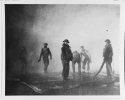 NS020526b |
227k | Firefighters at work aboard USS Yorktown (CV-5), after the ship was hit by three Japanese bombs shortly after noon on 4 June 1942. This view was probably taken in the hangar as crewmen were extinguishing fires set by a bomb that detonated on the flight deck just aft of the midships elevator. Official U.S. Navy Photograph, now in the collections of the National Archives and Records Administration (NARA), photo # 80-G-11642. |
Naval History & Heritage Command (NH&HC) |
 NS020525a |
89k | A Japanese Aichi D3A2 Val dive bomber homes in on USS Yorktown. This dramatic still from a movie was photographed by Photographer's Mate Second Class William G. Roy with a 35mm Bell & Howell motion picture camera, which was later recovered by Otis Kight (VF-42). Photo © William G. Roy. |
Robert Hurst |
 NS020526 |
87k | USS Yorktown (CV-5) is hit on the port side, amidships, by a Japanese Type 91 aerialtorpedo during the mid-afternoon attack by planes from the carrier Hiryu, 4 June 1942. Photographed from USS Pensacola (CA-24). Yorktown is heeling to port and is seen at a different aspect than in other views taken by Pensacola, indicating that this is the second of the two torpedo hits she received. Note very heavy anti-aircraft fire. Official U.S. Navy Photograph, now in the collections of the National Archives (photo # 80-G-414423). |
Scott Dyben |
 NS020526i |
253k | Japanese Type 97 carrier-borne attack aircraft (Nakajima B5N, allied report code Kate) from the carrier Hiryu amid heavy anti-aircraft fire, during the torpedo attack on USS Yorktown (CV-5) in the mid-afternoon, 4 June 1942. At least three planes are visible, the nearest clearly having already dropped its torpedo. The other two are lower and closer to the center, apparently withdrawing. Smoke on the horizon in right center is from a crashed plane. It is possible that the object very close to the horizon, in center, is another attacking aircraft. Official U.S. Navy Photograph, now in the collections of the National Archives and Records Administration (NARA), photo # 80-G-11639. |
Naval History & Heritage Command (NH&HC) |
 NS020526a |
232k | Looking forward on the flight deck of USS Yorktown (CV-5) shortly after she was hit by two Japanese aerial torpedoes, 4 June 1942. Men are preparing to abandon ship. Island's port side is at right, with the curved supporting structure for the Primary Flight Control booth at top. Knotted lines in the foreground were apparently used to evacuate the island's upper platforms. Official U.S. Navy Photograph, now in the collections of the U.S. National Archives (photo # 80-G-21603). |
Gerd Matthes, Germany |
 NS020526b |
283k | Looking to port, amidships, on the flight deck of USS Yorktown (CV-5) shortly after she was hit by two Japanese aerial torpedoes, 4 June 1942. View shows the damaged port side catwalk at between about Frames 83 & 90, which was broken and bent upwards by the explosion of an aerial torpedo on the hull below. Arresting gear wire visible is that located at about Frame 91.5. This appears to be a partial double-exposure, with the second image, at bottom, showing the tail of an F4F aircraft. Official U.S. Navy Photograph, now in the collections of the U.S. National Archives (photo # 80-G-21604). |
Gerd Matthes, Germany |
 NS020526c |
207k | View of the upper after end of USS Yorktown's island, taken on 4 June 1942, during the battle. Official U.S. Navy Photograph, now in the collections of the U.S. National Archives (photo # 80-G-21610). |
Gerd Matthes, Germany |
 NS020526e |
172k | USS Yorktown (CV-5) is abandoned after receiving damage from two Japanese aerial torpedoes, 4 June 1942. Destroyers at right are picking up survivors. The most distant of the two destroyers is USS Balch (DD-363). Official U.S. Navy Photograph, now in the collections of the U.S. National Archives (#80-G-22231). |
Gerd Matthes, Germany |
 NS020526g |
250k | Scene on the flight deck of USS Yorktown (CV-5) shortly after she was hit by two Japanese aerial torpedoes, 4 June 1942. Men are balancing themselves on the listing deck as they prepare to abandon ship. This view looks aft from alongside the island. F4F-4 Wildcat fighter visible in the background is Fighting Squadron Three's Plane # 6 (Bureau # 5165), which had been flown by Ensign Brainard T. Macomber during the morning attacks on the Japanese carrier fleet. Insufficient fuel prevented it from being launched to defend Yorktown from the afternoon torpedo plane attack. Note life jacket worn by man at right. Official U.S. Navy Photograph, now in the collections of the U.S. National Archives and Records Administration (NARA), # 80-G-14384. |
Bob Canchola, BT, USN (Ret.) |
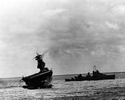 NS020526h |
267k | USS Yorktown (CV-5) being abandoned by her crew after she was hit by two Japanese Type 91 aerial torpedoes, 4 June 1942. USS Balch (DD-363) is standing by at right. Note oil slick surrounding the damaged carrier, and inflatable life raft being deployed off her stern. Official U.S. Navy Photograph, now in the collections of the U.S. National Archives and Records Administration (NARA), # 80-G-17061. |
Bob Canchola, BT, USN (Ret.) |
 NS020526d |
194k | USS Yorktown (CV-5), in the distant left center, being abandoned after suffering torpedo damage, 4 June 1942. A destroyer is standing by off the listing carrier's stern, and USS Vincennes (CA-44) is steaming by in the middle distance. Official U.S. Navy Photograph, now in the collections of the National Archives (photo # 80-G-21664). |
Gerd Matthes, Germany |
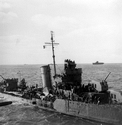 NS020526f |
294k | USS Benham (DD-397), with 720 survivors of USS Yorktown (CV-5) aboard, closes USS Portland (CA-33) at about 1900 hrs, 4 June 1942. A report of unidentified aircraft caused Benham to break away before transferring any of the survivors to the cruiser and they remained aboard her until the following morning. Note Benham's oil-stained sides. The abandoned Yorktown is in the right distance. Naval History & Heritage Command photo, # NH 95574. |
Gerd Matthes, Germany |
 NS0539717 |
78k | Destroyers stand by to pick up survivors as USS Yorktown (CV-5) is abandoned during the afternoon of 4 June 1942, following Japanese torpedo plane attacks. Destroyers at left are (left to right): Benham (DD-397), Russell (DD-414), and Balch (DD-363). Destroyer at right is Anderson (DD-411). Photographed from USS Pensacola (CA-24). Official U.S. Navy Photograph, now in the collections of the U.S. National Archives (photo # 80-G-21694). |
Fabio Peña Gerd Matthes, Germany |
 NS020535 |
109k | USS Yorktown (CV-5) lists heavily after she was abandoned during the afternoon of 4 June 1942. Note that two F4F-4 Wildcat fighters are still parked on her flight deck, aft of the island. Official U.S. Navy Photograph, now in the collections of the National Archives (photo # 80-G-21666). |
Steve Whitby |
 NS020564 |
131k | Aviation Ordnanceman Second Class Clifton R. Bassett, of Yorktown's Bombing Squadron Three (VB-3), is carried from the flight deck of USS Enterprise (CV-6), 4 June 1942. He had been wounded by Japanese aircraft while VB-3 was attacking Hiryu. Bassett was radioman/gunner of the SBD Dauntless scout-bomber flown by Ensign Bunyan R. Cooner, USNR, seen here at top center wearing an inflatable life jacket. Photographed looking forward from the carrier's island. Note flight deck details, including wooden decking, metal tie-down strips, palisade and flight deck distance markings. Aircraft wheel chocks are piled at the right. Official U.S. Navy Photograph, now in the collections of the National Archives (photo # 80-G-7745). |
NH&HC |
 NS020564a |
154k | Aviation Ordnanceman Second Class Clifton R. Bassett, of Yorktown's Bombing Squadron Three (VB-3), is carried from the flight deck of USS Enterprise (CV-6), 4 June 1942. He had been wounded by Japanese aircraft while VB-3 was attacking Hiryu. Bassett was radioman/gunner of the SBD Dauntless scout-bomber flown by Ensign Bunyan R. Cooner, USNR, seen here walking to the right of the stretcher party. Photographed looking forward from the carrier's island. Note flight deck distance markings and aircraft tie-down strips. Official U.S. Navy Photograph, now in the collections of the National Archives (photo # 80-G-7746). |
|
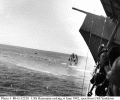 NS0541204 |
59k | USS Hammann (DD-412) sinking with stern high, after being torpedoed by Japanese submarine I-168 in the afternoon of 6 June 1942. Photographed from the starboard forecastle deck of USS Yorktown (CV-5) by Photographer 2nd Class William G. Roy. Angular structure in right foreground is the front of Yorktown's forward starboard 5-inch gun gallery. Note knotted lines hanging down from the carrier's flight deck, remaining from her initial abandonment on 4 June. Official U.S. Navy Photograph, now in the collections of the National Archives (photo # 80-G-32320). |
Joe Radigan |
 NS020558 |
191k | USS Hammann (DD-412) disappears beneath the waves, after being torpedoed by Japanese submarine I-168 in the afternoon of 6 June 1942. Photographed from the starboard forecastle deck of USS Yorktown (CV-5) by Photographer 2nd Class William G. Roy. Official U.S. Navy Photograph, now in the collections of the National Archives (photo # 80-G-32321). |
Gerd Matthes, Germany |
 NS020567 |
118k | USS Yorktown (CV-5) sinking, just after dawn on 7 June 1942, as seen from an accompanying destroyer. The ship has capsized to port and is settling rapidly by the stern. This view looks over the ship's upper starboard structure, with her forefoot and front edge of the flight deck in the center. A .50 caliber machine gun tub is on the front corner of the flight deck, with the ship's bow and its 20mm gun tub visible beyond the flight deck's front. Naval History & Heritage Command photo (# NH 106011). |
Gerd Matthes, Germany |
 NS020567a |
244k | USS Yorktown (CV-5) sinking, just after dawn on 7 June 1942, as seen from an accompanying destroyer. The carrier has capsized to port, exposing the turn of her starboard bilge, with a large torpedo hole amidships severing the forward bilge keel. Yorktown's forefoot is at the extreme right. Her starboard forward 5-inch gun gallery can be seen further up her hull, with two 5"/38 gun barrels sticking out over its edge. The two larger thin objects sticking up, just aft of the 5-inch guns, are aircraft parking outriggers. When the ship's wreck was examined in May 1998, both guns were still in position, but the outriggers were gone. Naval History & Heritage Command (NH&HC) photo, # NH 95575. |
Gerd Matthes, Germany |
 NS020551 |
74.8Mb | "The Battle of Midway," directed by John Ford and narrated by Henry Fonda, is comprised mostly of authentic footage from the battle. This documentary, produced in 1942, won an Academy Motion Picture Arts and Sciences Award (Oscar). Then Commander (later Rear Admiral) John Ford, USNR, in civil life wrote, directed or produced more than 130 films in a career spanning four decades. Format: MP4 (.mp4) Duration: 18' 7" Size: 320 x 240 Download a free MP4 player. Another collection of footage taken by John Ford is available at Live Leak. |
Courtesy of Internet Archive. Thanks to Ron Reeves for the clue. |
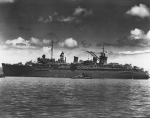 NS09361106 |
111k | USS Fulton (AS-11) arrives at Pearl Harbor with USS Yorktown (CV-5) survivors on board, 8 June 1942, following the Battle of Midway. US Navy photo now in the collections of the US National Archives (# 80-G-10120). |
Naval History & Heritage Command |
| The Crew |
|||
 NS0573904 |
44k | Samuel Adams was born at Northampton, Massachusetts, on 10 April 1912. Graduated from the U.S. Naval Academy in 1935, he was designated a Naval Aviator in January 1939. He joined Bombing Squadron Five (VB-5) on USS Yorktown (CV-5) in May 1939 and served with that unit through the first six months of the Pacific war. On 4 June 1942, during a Battle of Midway scouting flight, Lieutenant Adams located the Japanese aircraft carrier Hiryu, a vital contribution to the destruction of that ship. On the following day, while attacking the Japanese destroyer Tanikaze, he lost his life when his SBD aircraft was shot down. Lieutenant Samuel Adams was posthumously awarded the Navy Cross for his actions during the Battle of Midway. Photograph taken at Naval Air Station, Pensacola, Florida, 31 January 1938, while he was in flight training. Photograph from the Bureau of Personnel Collection in the U.S. National Archives (# 80-PA-1A-22.) Destroyer, later light minelayer, USS Adams (DD-739 / DM-27 / MMD-27), was named after him. |
NHC |
 NS020561 |
87k | Captain Stanford E. Linzey, Jr., CHC, USN (Ret.), survived the Battle of the Coral Sea and the Battle of Midway. At the time, he was a 21-year old Seaman Second Class stationed on the USS Yorktown (CV-5). Read "A Tribute to the Late Captain Stanford E. Linzey, Jr.", by his son, Dr. James F. Linzey. |
James F. Linzey, D.D. Chaplain (MAJOR) CAARNG (Ret.) |
 NS020571 |
126k | Page from Yorktown's survivors Muster List. (Note that the name of Harry F. Schanbacher is misspelled.) |
Jeff Schanbacher, son of Harry F. "Dutch" Schanbacher |
| Memorabilia |
|||
 NS020588 |
258k | Stamp, 1942, Robert Lash Robbins, Postamp Pub. Co. Torpedo Squadron (VT) 5 insignia adopted during the later 1930s, when VT-5 served aboard USS Yorktown (CV-5). |
Tommy Trampp |
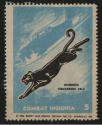 NS020588a |
270k | Stamp, 1942, Robert Lash Robbins, Postamp Pub. Co. Bombing Squadron (VB) 3 insignia. The Battle of Midway marked the combat debut of VB-3. Launching from USS Yorktown (CV-5), they attacked and sank Japanese carrier Soryu, 4 June 1942. Later in the day, launching from USS Enterprise (CV-6), VB-3 attacked and sank another Japanese carrier, Hiryu. |
|
 NS020588b |
59k | Stamps, 1942 and 1943, Robert Lash Robbins, Postamp Pub. Co. Bombing Squadron (VB) 5 insignia adopted during the later 1930s, when VB-5 served aboard USS Yorktown (CV-5). |
|
 NS020588c |
126k | ||
 NS020555 |
60k | "U.S.S. Yorktown — Third Anniversary Ball — Alexander Young Hotel, Honolulu, T.H. — September 30, 1940" Official caption states this photo shows Yorktown anchored in a Haitian harbor, circa 1938–1940. |
Jim Sinnott Collection. Courtesy of Carol Edgemon Hipperson, author of "Radioman: An Eyewitness Account of Pearl Harbor and World War II in the Pacific." |
 NS020569 |
357k | USS Yorktown, Bombing Squadron Five, Thanksgiving Day 1941 Menu. |
Jeff Schanbacher, son of Harry F. "Dutch" Schanbacher |
 NS020570 |
346k | USS Yorktown, Christmas Dinner 1941 Menu. |
Jeff Schanbacher, son of Harry F. "Dutch" Schanbacher |
|
|||
| Crew Contact and Reunion Information | ||||||||||||||||
|
| Related Links |
|
Hazegray & Underway World Aircraft Carrier Pages by Andrew Toppan. War Damage Report No. 25, 4-7 June 1942 located on the HyperWarwebsite |
| Main Photo Index |
Aircraft Carrier Photo Index Page |
Comments, Suggestions or Image submissions, E-mail Carrier Information
Problems and site related matters, E-mail Webmaster
This page was created by Paul Yarnall and is maintained by Fabio Peña
![]()
Last update: 6 August 2024